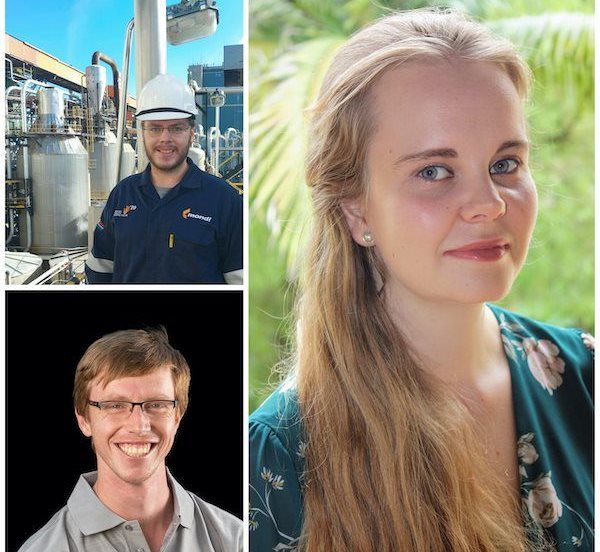Three SA researchers shortlisted in international forestry research award
Three South African researchers have made it to the global shortlist of the Blue Sky Young Researchers and Innovation Awards. They were selected from 14 candidates in the South African round.
Justin Phillips and Hester Oosthuizen, both from the University of Pretoria, and Eddie Barnard from Stellenbosch University go up against another 18 of their peers from around the world, with only three of the finalists earning cash prizes and the opportunity to present their work at the ICFPA's Global CEO Roundtable virtual discussion on 29 April.
Justin Phillips and Hester Oosthuizen, both from the University of Pretoria, and Eddie Barnard from Stellenbosch University go up against another 18 of their peers from around the world, with only three of the finalists earning cash prizes and the opportunity to present their work at the ICFPA's Global CEO Roundtable virtual discussion on 29 April.

Image Supplied.
The awards, launched in 2016 by the International Council of Forest and Paper Associations (ICFPA), aim to recognise, celebrate and promote innovations being developed in the global forestry sector.
"We are immensely proud of our finalists for making it this far, and demonstrating that South Africa can hold its own against the best in the world," says Jane Molony, executive director of the Paper Manufacturers Association of South Africa (Pamsa). "As a sector, we constantly look for ways to support young people with an interest in science and technology and are proud of the career opportunities our member companies can offer them."
Furniture from paper sludge and cattle dip for killing ticks
Barnard is exploring the commercial viability of using technical lignin (a by-product from the wood pulping phase in pulp or paper making) and pulp and paper sludge (rejected, degraded, and spilled fibres and water from the pulping and papermaking processes) to make composite materials.
Lignin has binding properties, which when combined with sludge, could be used to make construction materials such as a replacement for particleboard. The use of lignin together with pulp and paper sludge could replace components that would otherwise be produced from fossil-based resources, and reduce associated waste, greenhouse gas emissions and disposal costs.
Phillips has looked at how starch and nano-cellulose can be used as a carrier material for pesticide application in the agricultural sector. The insoluble solid active ingredient in the pesticide attaches to the carrier, which is water-soluble and allows for safer and more efficient and safe controlled release of the pesticide, especially in aqueous environments such as animal dipping for tick prevention.
Cellulose is uniquely positioned to substitute many petroleum-based plastics, however, it cannot be melt-processed and dissolved using common organic solvents. This is why Oosthuizen examined the efficacy of using choline chloride and ionic liquids, considered greener and less volatile, to make cellulose fluid enough to produce cellulose-based materials using existing polymer processing techniques.
Wood – a renewable alternative to conventional materials
As a sustainably farmed resource that stores carbon, wood is increasingly being used not only in the built environment for houses and high-rises, but also for its cellulose, lignin and sugars. These elements all have a role in helping the world find renewable and low-carbon alternatives to the likes of plastic, chemicals, steel and concrete.
"Two key advantages that commercially farmed trees bring are their renewability and their carbon storage," explains Molony. "The fact that trees are sustainably planted, harvested and replenished on the same land makes both wood and paper products renewable and efficient resources. For a low carbon future, it’s tremendously exciting – especially when we look at the kind of research our young scientists are producing."
An international panel with connections to industry, academia and public policy has been assembled to judge the awards, including:
• Lyndall Bull, Forestry Officer at the Food and Agriculture Organisation of the United Nations (UN)
• Barbara Tavora Jainchill, Programme Management Officer, Forest Affairs, with the UN Forum on Forests Secretariat
• Fernando L. Garcia Bertolucci, Executive Director of Technology and Innovation at Suzano S.A. and Member of IUFRO
• Professor Gil Garnier, Director of BioPRIA within the Department of Chemical Engineering at Monash University
• John Innes, Dean of the Faculty of Forestry at University of British Columbia.
The local round was adjudicated by Valeske Cloete (Mpact), Sanet Minnaar (Sappi) and Mike Nash, former head of Pamsa’s Process Research Unit and experienced chemical engineer.
"South African Martin Wierzbicki was among the top three in the final international award in 2019," concludes Molony. "We’ll be rooting for this year’s three finalists to go all the way to the top."